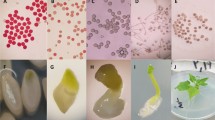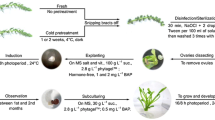Abstract
In this study, the effect of spraying mother plants with various levels of putrescine, spermidine, and cycocel (each at 0, 50, 500, and 5000 mg/l) were assessed on the frequency of haploid embryos produced from unfertilized ovaries and subsequent regeneration of derived embryos. Significantly higher haploid embryos were obtained when mother plants were sprayed with putrescine at 500 mg/l (5.2 embryos/fruit), spermidine at 50 mg/l (4.8 embryos/fruit), and cycocel at 50 mg/l (5.2 embryos/fruit) as compared to the control (without spraying, 3.2 embryos/fruit). However, embryogenesis induction was decreased drastically as the concentration of all the three compounds tested was increased and the lowest haploid embryos were observed when 5000 mg/l of spermidine (0.4 embryos/fruit) or cycocel (2.0 embryos/fruit) were applied. Only spermidine at 50 mg/l led to 100% regeneration into fully developed plantlets. The seed setting and size of fruits were also affected by polyamines and cycocel applications. Ploidy analysis using a flow cytometer indicated that all regenerated plantlets contain the gametic chromosome number (n = x = 7) of parental plants and the results of chromosome counting also confirmed the haploid nature of regenerated plantlets. It can be concluded that the induction of haploid embryogenesis from unfertilized ovaries after pollination with irradiated pollen and subsequent conversion of derived embryos into the plantlets could be improved in Cucumis sativus L. by applying appropriate levels of putrescine, spermidine, and cycocel.


Similar content being viewed by others
References
Abd El-Migeed MMM, Mostafa EAM, Ashour NE, Hassan HSA, Mohamed DM, Saleh MMS (2013) Effect of potassium and polyamine sprays on fruit set, fruit retention, yield and fruit quality of Amhat date palm. Int J Agric Res 8(2):77–86
Ahamdi B, Shariatpanahi ME, Ojaghkandi MA, Heydari AA (2014) Improved microspore embryogenesis induction and plantlet regeneration using putrescine, cefotaxime and vancomycin in Brassica napus L. Plant Cell Tissue Organ Cult 118:497–505
Alifar M, Ebadi A, FatahiMoghadam MR (2015) Effects of putrescine and chlormequat pre-flowering treatment on embryo rescue technique success in diallele crosses of grape cultivars Flame Seedless, perlette and Yaghooti. Iran J Hortic Sci 46(2):179–192
Altinas S (2011) Effects of chlormequat chloride and different rates of prohexadione-calcium on seedling growth, flowering, fruit development and yield of tomato. Afr J Biotechnol 10(75):17160–17169
Aydin M, Hossein Pour A, Haliloglu K, Tosun M (2016) Effect of polyamines on somatic embryogenesis via mature embryo in wheat. Turk J Biol 40:1178–1184
Baron K, Stasolla C (2008) The role of polyamines during in vivo and in vitro development. In Vitro Cell Dev Biol Plant 44:384–395
Bibi A, Oosterhuis D, Gonias E (2012) Changes in the ovarian polyamine content and seed set efficiency of cotton by the plant growth regulator BM86″. Am J Plant Sci 3(9):1328–1335
Chen J-T, Chang W-C (2003) Effects of GA3, ancymidol, cycocel and paclobutrazol on direct somatic embryogenesis of Oncidium in vitro. Plant Cell Tissue Organ Cult 75:105–108
Chen JF, Sraub JE, Jiang J (1998) A reevaluation of karyotype in cucumber (Cucumis sativus L.). Genet Res Crop Evol 45(4):301–305
Dong YQ, Zhao WX, Li XH, Liu XC, Gao NN, Huang JH, Wang WY, Xu XL, Tang ZH (2016) Androgenesis, gynogenesis, and parthenogenesis haploids in cucurbit species. Plant Cell Rep 35(10):1991–2019
Ebrahimi R, Zamani Z (2009) Effect of polyamines on in vitro gynogenesis of onion (Allium cepa L.). Am Eur J Sustain Agric 3(1):71–74
El Meskaoul A, Trembaly FM (2009) Effects of exogenous polyamines and inhibitors of polyamine biosynthesis on endogenous free polyamine contents and the maturation of white spruce somatic embryos. Afr J Biotechnol 8(24):6807–6816
Gałązka J, Niemirowicz-Szczytt K (2013) Review of research on haploid production in cucumber and other cucurbits. Folia Hortic 25(1):67–78
Gémes Juhász A, Balogh P, Ferenczy A, Kristóf Z (2002) Effect of optimal stage of female gametophyte and heat treatment on in vitro gynogenesis induction in cucumber (Cucumis sativus L.). Plant Cell Rep 21:105–111
Gorecka K, Kiszczak W, Krzyzanowska D, Kowalska U, Kapuscinska A (2014) Effect of polyamines on in vitro anther cultures of carrot (Daucus carota L.). Turk J Biol 38:593–600
Haque S, Farooqi AHA, Gupta MM, Sangwan RS, Khan A (2007) Effect of ethrel, chlormequat chloride and paclobutrazol on growth and pyrethrins accumulation in Chrysanthemum cinerariaefolium Vis. Plant Growth Regul 51:263–269
Imai A, Matsuyama T, Hanzawa Y, Akiyama T, Tamaoki M, Saji H, Shirano Y, Kato T, Hayashi H, Shibata D, Tabata S, Komeda Y, Takahashi T (2004) Spermidine synthase genes are essential for survival of Arabidopsis. Plant Physiol 135:1565–1573
Kamiab F, Salehabad MH, Zamani bahramabadi E (2015) Evaluation the effects of foliar treatments of polyamines and some organic acids on quantitative and qualitative traits in some pistachio cultivars. J Nuts 6(2):131–142
Kong L, Attree SM, Fowke LC (1998) Effects of polyethylene glycol and methylglyoxalbis (guanylhydrazone) on endogenous polyamine levels and somatic embryo maturation in white spruce (Picea glauca). Plant Sci 133:211–220
Kumar HGA, Ravishankar BV, Murthy HN (2004) The influence of polyamines on androgenesis of Cucumis sativus L. Eur J Hortic Sci 69(5):201–205
Lewitsky GA (1931) An essay on cytological analysis of the fixing action of the chrom-acetic formalin and the chromic formalin. Bull Appl Bot 27(1):181–185
Lotfi M, Alan AR, Henning MJ, Jahn MM, Earle ED (2003) Production of haploid and doubled haploid plants of melon (Cucumis melo L.) for use in breeding for multiple virus resistance. Plant Cell Rep 21:1121–1128
Malá J, Cvikrová M, Máchová P, Martincová O (2009) Polyamines during somatic embryo development in Norway spruce (Picea abies [L.]). J For Sci 55(2):75–80
Malik AU, Singh Z (2006) Improved fruit retention, yield and fruit quality in mango with exogenous application of polyamines. Sci Hortic 110:167–174
Martínez LE, Agüero CB, López ME, Galmarini CR (2000) Improvement of in vitro gynogenesis induction in onion (Allium cepa L.) using polyamines. Plant Sci 156(2):221–226
Miroshnichenko D, Filippov M, Doglov S (2009) Effects of daminozide on somatic embryogenesis from immature and mature embryos of wheat. Aust J Crop Sci 3(2):83–94
Mukherjee A, Bandyopadhyay A (2014) Inducing somatic embryogenesis by polyamines in medicinally important Clerodendrum indicum L. Int J Curr Microbiol App Sci 3(8):12–26
Mulualem T, Abate M (2016) Heterotic Response in Major Cereals and Vegetable Crops. Int J Plant Breed Genet 10(2):69–78
Musial K, Usial K, Bohanec B, Przywara L (2001) Embryological study on gynogenesis in onion (Allium cepa L.). Plant Reprod 13:335–341
Passam HC, Koutri AC, Karapanos IC (2008) The effect of chlormequat chloride (CCC) application at the bolting stage on the flowering and seed production of lettuce plants previously treated with water or gibberellic acid (GA3). Sci Hortic 116(2):117–121
Paul A, Mitter K, Raychaudhuri SS (2009) Effect of polyamines on in vitro somatic embryogenesis in Momordica charantia L. Plant Cell Tissue Org Cult 97(3):303–311
Ponce MT, Guinazo M, Tizio R (2002) Effect of putrescine on embryo development in the stenospermocarpic grape cvs Emperatriz and Fantasy. Vitis 41(1):53–54
Ponce M, Martinez L, Galmarini C (2006) Influence of CCC, putrescine and gellam gum concentration on gynogenic embryo induction in Allium cepa. Biol Plant 50(3):425–428
Przyborowski JA, Niemirowicz-Szczytt K (1994) Main factors affecting cucumber (Cucumis sativus L.) haploid embryo development and haploid plant characteristics. Plant Breed 112:70–75
Pullman GS, Mein J, Johnson S, Zhang Y (2005) Gibberellin inhibitors improve embryogenic tissue initiation in conifers. Plant Cell Rep 23:596–605
Rademacher W (2000) Growth retardants: effects on gibberellin biosynthesis and other metabolic pathways. Ann Rev Plant Physiol Plant Mol Biol 51:501–531
Redha A, Suleman P (2009) Assessment of polyamines and trehalose in wheat microspores culture for embryogenesis and green regenerated plants. Am J Plant Sci 4:2218–2226
Saleem BA, Malik AU, Anwar R, Farooq M (2006) Exogenous application of polyamines improves fruit set, yield and quality of sweet oranges. Acta Hortic 774:187–194
Sargent HR, Godwin ID, Adkins SW (1998) The effect of exogenous polyamines on somatic embryogenesis and plant regeneration from Sorghum bicolor and Saccharum spp. Acta Hortic 461:451–458
Sauton A, Dumas de Vaulx R (1987) Production of haploid plants in melon (Cucumis melo L.) as a result of gynogenesis induced by irradiated pollen. Agronomie 7(2):141–147
Shakhanokho HF, Ozias-Akins P, May L, Chee PW (2005) Putrescine enhances somatic embryogenesis and plant regeneration in upland cotton. Plant Cell Tissue Organ Cult 81:91–95
Shariatpanahi ME, Ahmadi B (2016) Isolated microspore culture and its applications in plant breeding and genetics. In: Anis M, Ahmad N (eds), Plant tissue culture: propagation, conservation and crop improvement. Springer Science + Business Media Singapore, pp 487–507
Silveira V, Floh EIS, Handro W, Guerra MP (2004) Effect of plant growth regulators on the cellular growth and levels of intracellular proteins, starch and polyamines in embryogenic suspension cultures of Pinustaeda. Plant Cell Tissue Organ Cult 76:53–60
Takahashi T, Kakehi J-I (2010) Polyamines: ubiquitous polycations with unique roles in growth and stress responses. Ann Bot 105:1–6
Thiruvengadam M, Rekha KT, Jayabalan N, Praveen N, Kin EH, Chung IM (2013) Effect of exogenous polyamines enhances somatic embryogenesis via suspension cultures of spine gourd (Momordica dioica Roxb. ex. Willd.). Aust J Crop Sci 7(3):446–453
Tiburcio A, Altabella T, Bitrián M, Alcázar R (2014) The roles of polyamines during the lifespan of plants: from development to stress. Planta 240(1):1–18
Urano K, Yoshiba Y, Nanjo T, Igarashi Y, Seki M, Sekiguchi F, Yamaguchi-Shinozaki K, Shinozaki K (2003) Characterization of Arabidopsis genes involved in biosynthesis of polyamines in abiotic stress responses and developmental stages. Plant Cell Environ 26(11):1917–1926
Wei A, Du S, Han Y, Zhang G (2010) A study on the relationship between cucumber gynogenesis and content of ovary hormones and polyamines. Acta Hortic 871:625–630
Zarifi E, Güloğlu D (2016) An improved Aceto-Iron-Haematoxylin staining for mitotic chromosomes in Cornelian cherry (Cornus mas L.). Caryologia 69(1):67–72
Zhang T, Wang X, Wang Y, Han J, Mao P, Majerus M (2009) Plant growth regulator effects on balancing vegetative and reproductive phases in alfalfa seed yield. Agron J 101:1139–1145
Acknowledgements
This research was supported by grants from Agricultural Biotechnology Research Institute of Iran (ABRII) Project No. 12-05-05-9451-94001.
Author information
Authors and Affiliations
Corresponding author
Ethics declarations
Conflict of interest
The authors declare that they have no conflict of interests.
Rights and permissions
About this article
Cite this article
Ebrahimzadeh, H., Shariatpanahi, M.E., Ahmadi, B. et al. Efficient Parthenogenesis Induction and In Vitro Haploid Plant Regeneration in Cucumber (Cucumis sativus L.) Using Putrescine, Spermidine, and Cycocel. J Plant Growth Regul 37, 1127–1134 (2018). https://doi.org/10.1007/s00344-018-9803-1
Received:
Accepted:
Published:
Issue Date:
DOI: https://doi.org/10.1007/s00344-018-9803-1




